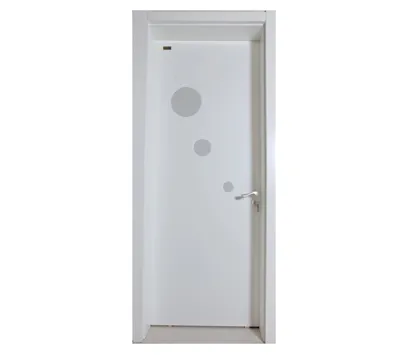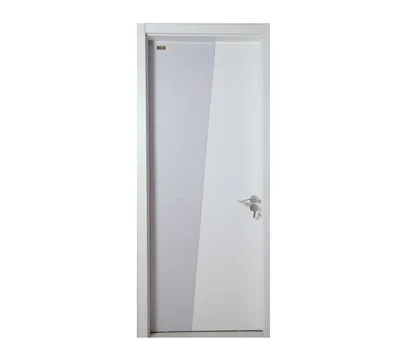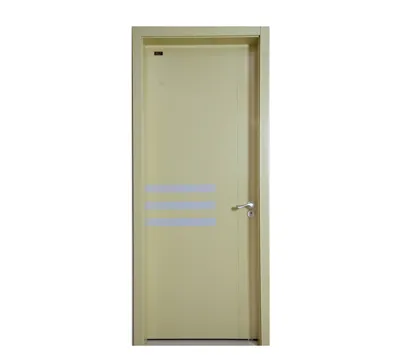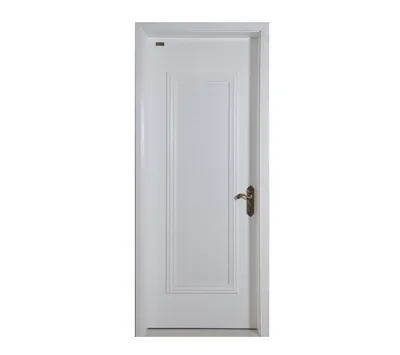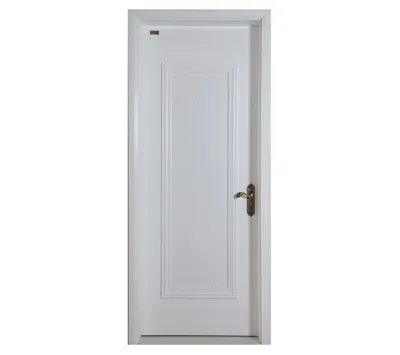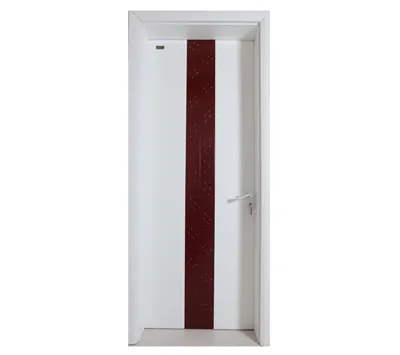
Eco-door Wood-plastic Door Dian Shang Series - smt-02 Purchase Method:
Four Look
First, inspect the finish (shape and paint color);
Second, examine the certification (for toxic substance content);
Third, consider the material (solid wood material);
Fourth, check the craftsmanship (whether the dimensions are regular and the seams are tight).
Only by mastering these "four observations" will you be able to distinguish between the true and the false in the maze of doors.
a can
When choosing a solid wood door, you can inspect its thickness and gently tap on the surface with your hand. If the sound is even and muffled, it indicates that the door is of good quality. Weight: Generally, the higher the proportion of solid wood in a wooden door, the heavier it will be. If it is a pure solid wood door, the surface patterns will be very irregular. At first glance, a door with smooth, neat, and beautiful surface patterns is often not a genuine solid wood door.
paint
As the final stage of processing in a factory that produces wooden door sets, the quality of the craftsmanship directly affects the final usage effect. At the same time, paint cost is also one of the largest components of the cost of wooden doors.
The types of paint can be broadly classified into phenolic paint, alkyd paint, polyurethane paint, nitrocellulose paint, polyester paint, and PU paint. Among them, phenolic paint and alkyd paint are basically eliminated in decoration due to their poor film texture and adhesion. Nitrocellulose paint, polyester paint, and PU paint used on high-end furniture are widely used. Nitrocellulose paint is used by most handcrafted decorative woodwork due to its simplicity in application and suitability for manual operation. However, its thin film, poor hand feel, and unsatisfactory effect make it less desirable.
Due to issues related to cost, processing methods, and equipment, 90% of the wooden door sets on the market use polyester paint, while a minority of manufacturers use PU paint. Generally speaking, both polyester paint and PU paint undergo six processes, including color matching, three coats of primer, and two coats of finish. Some brands add curing and waxing processes.
Therefore, when choosing wooden doors, paint is one of the factors to consider, as it directly affects issues such as texture, feel, moisture resistance, environmental friendliness, durability, and resistance to yellowing.
Selection Techniques
1. First, consider the style and color. The purpose of decorating a house is to create a warm and harmonious living environment. Therefore, when choosing wooden doors, the first thing to consider is whether the style and color of the wooden doors match the style of the living room. If the decorative style is calm and plain, choose a generous and simple style; if it is lively and bright, choose a light and elegant style; if it is classical and comfortable, decorate with a heavy and elegant style. In short, it is recommended to choose styles that are similar or close to each other,
2. Consider the color scheme. Good color matching is a key element in decorating a living space. Therefore, after determining the style, the next thing to consider is the matching of the color of the wooden door with the color scheme of the living room. The color scheme of the living room is mainly based on similar shades with some contrasting elements for emphasis. We can first divide the overall color and brightness of the living room into three major color schemes: walls, floor, and soft furnishings. Basically, maintaining these three major color schemes is sufficient, without going overboard. The color of the wooden door can be considered to be close to the color scheme of the furniture. For example, if the floor is dark and the walls are white, a purple-tinged wooden door can be paired. This way, there is both contrast and harmony in the overall color scheme. If you are not sure or do not have the guidance of a professional, I recommend this "relying on" method. Don't always think about contrast everywhere. In fact, the overall environment already has contrast. You just need to find a color for the door that is close to the overall environment, whether it's the floor, walls, or furniture, and then differentiate in details. For example, the texture of the wooden door can be matched differently from the wood grain of the floor. As for which color scheme to rely on, it depends on the actual situation.
3. Feel the texture. After thoroughly considering the style and color, the next step is to assess the craftsmanship and quality of the product. It is unlikely that we can go to the factory to watch how it is processed, so we can only evaluate the craftsmanship quality of the product through simple visual inspection methods. Here are two words to teach you: touch and sidelight observation. Touch the door's frame, panel, and corners with your hand, ensuring there is no scratching sensation, and that it feels soft and delicate. Then stand on the side of the door and observe the paint surface in the light to see if there are any bumps or waves. Basically, these two steps can tell you whether the workmanship is qualified.
4. Inspect the materials used and the relevant qualification certificates of the manufacturer. However, based on the above, we cannot yet say that we can buy back satisfactory and assured wooden doors. What is the internal material used in the wooden door? Is it environmentally friendly? Here, we can inspect it through three aspects: First, try to choose manufacturers with good brand reputation. The Wooden Door Professional Committee of the China Timber Distribution Association held a wooden door industry conference in Beijing, where they selected the top 30 enterprise member units of the Chinese wooden door industry through rigorous research and investigation. These manufacturers are relatively standardized in terms of scale, product quality, and service system. Second, measure the product structure by checking whether the manufacturer's relevant qualification certificates are complete and authentic in comparison to relevant industry standards. Third, pay attention to checking the internal materials used in the door lock hole area before installation as a final check.
In addition, price is also a factor in assessing quality. Genuine materials cannot be too cheap. Every type of product has a certain cost. Quotations below its cost limit are questionable. For example, the production cost of a fully solid wood door should be around 3,000 yuan. If the merchant quotes 2,500 yuan, there must be a problem.
In summary, when purchasing indoor doors, follow the steps mentioned above to avoid the pitfall of being led by the nose by merchants due to confusion.
For more information about eco-friendly interior doors, please feel free to contact us.

Eco-door Wood-plastic Door Dian Shang Series - smt-02 Purchase Method:
Four Look
First, inspect the finish (shape and paint color);
Second, examine the certification (for toxic substance content);
Third, consider the material (solid wood material);
Fourth, check the craftsmanship (whether the dimensions are regular and the seams are tight).
Only by mastering these "four observations" will you be able to distinguish between the true and the false in the maze of doors.
a can
When choosing a solid wood door, you can inspect its thickness and gently tap on the surface with your hand. If the sound is even and muffled, it indicates that the door is of good quality. Weight: Generally, the higher the proportion of solid wood in a wooden door, the heavier it will be. If it is a pure solid wood door, the surface patterns will be very irregular. At first glance, a door with smooth, neat, and beautiful surface patterns is often not a genuine solid wood door.
paint
As the final stage of processing in a factory that produces wooden door sets, the quality of the craftsmanship directly affects the final usage effect. At the same time, paint cost is also one of the largest components of the cost of wooden doors.
The types of paint can be broadly classified into phenolic paint, alkyd paint, polyurethane paint, nitrocellulose paint, polyester paint, and PU paint. Among them, phenolic paint and alkyd paint are basically eliminated in decoration due to their poor film texture and adhesion. Nitrocellulose paint, polyester paint, and PU paint used on high-end furniture are widely used. Nitrocellulose paint is used by most handcrafted decorative woodwork due to its simplicity in application and suitability for manual operation. However, its thin film, poor hand feel, and unsatisfactory effect make it less desirable.
Due to issues related to cost, processing methods, and equipment, 90% of the wooden door sets on the market use polyester paint, while a minority of manufacturers use PU paint. Generally speaking, both polyester paint and PU paint undergo six processes, including color matching, three coats of primer, and two coats of finish. Some brands add curing and waxing processes.
Therefore, when choosing wooden doors, paint is one of the factors to consider, as it directly affects issues such as texture, feel, moisture resistance, environmental friendliness, durability, and resistance to yellowing.
Selection Techniques
1. First, consider the style and color. The purpose of decorating a house is to create a warm and harmonious living environment. Therefore, when choosing wooden doors, the first thing to consider is whether the style and color of the wooden doors match the style of the living room. If the decorative style is calm and plain, choose a generous and simple style; if it is lively and bright, choose a light and elegant style; if it is classical and comfortable, decorate with a heavy and elegant style. In short, it is recommended to choose styles that are similar or close to each other,
2. Consider the color scheme. Good color matching is a key element in decorating a living space. Therefore, after determining the style, the next thing to consider is the matching of the color of the wooden door with the color scheme of the living room. The color scheme of the living room is mainly based on similar shades with some contrasting elements for emphasis. We can first divide the overall color and brightness of the living room into three major color schemes: walls, floor, and soft furnishings. Basically, maintaining these three major color schemes is sufficient, without going overboard. The color of the wooden door can be considered to be close to the color scheme of the furniture. For example, if the floor is dark and the walls are white, a purple-tinged wooden door can be paired. This way, there is both contrast and harmony in the overall color scheme. If you are not sure or do not have the guidance of a professional, I recommend this "relying on" method. Don't always think about contrast everywhere. In fact, the overall environment already has contrast. You just need to find a color for the door that is close to the overall environment, whether it's the floor, walls, or furniture, and then differentiate in details. For example, the texture of the wooden door can be matched differently from the wood grain of the floor. As for which color scheme to rely on, it depends on the actual situation.
3. Feel the texture. After thoroughly considering the style and color, the next step is to assess the craftsmanship and quality of the product. It is unlikely that we can go to the factory to watch how it is processed, so we can only evaluate the craftsmanship quality of the product through simple visual inspection methods. Here are two words to teach you: touch and sidelight observation. Touch the door's frame, panel, and corners with your hand, ensuring there is no scratching sensation, and that it feels soft and delicate. Then stand on the side of the door and observe the paint surface in the light to see if there are any bumps or waves. Basically, these two steps can tell you whether the workmanship is qualified.
4. Inspect the materials used and the relevant qualification certificates of the manufacturer. However, based on the above, we cannot yet say that we can buy back satisfactory and assured wooden doors. What is the internal material used in the wooden door? Is it environmentally friendly? Here, we can inspect it through three aspects: First, try to choose manufacturers with good brand reputation. The Wooden Door Professional Committee of the China Timber Distribution Association held a wooden door industry conference in Beijing, where they selected the top 30 enterprise member units of the Chinese wooden door industry through rigorous research and investigation. These manufacturers are relatively standardized in terms of scale, product quality, and service system. Second, measure the product structure by checking whether the manufacturer's relevant qualification certificates are complete and authentic in comparison to relevant industry standards. Third, pay attention to checking the internal materials used in the door lock hole area before installation as a final check.
In addition, price is also a factor in assessing quality. Genuine materials cannot be too cheap. Every type of product has a certain cost. Quotations below its cost limit are questionable. For example, the production cost of a fully solid wood door should be around 3,000 yuan. If the merchant quotes 2,500 yuan, there must be a problem.
In summary, when purchasing indoor doors, follow the steps mentioned above to avoid the pitfall of being led by the nose by merchants due to confusion.
For more information about eco-friendly interior doors, please feel free to contact us.
